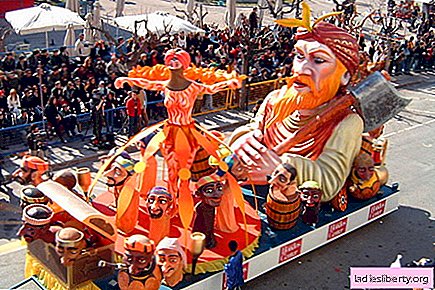
Holidays February 5
Apocries - Pancake Week in Greece
February 5 in Greece annually hosts a three-week carnival, which is called the Greek carnival. Apocries is an ancient tradition of the Greek hinterland. According to custom, folk carnivals are held in many parts of Greece, where the old traditions of dressing up have been preserved and restored. In the cities of Xanthi, Nausa, Grevena, Thebes, and on the island of Chios are crazy carnival processions and festivities. In Sparta, Kefalonia and in other cities, parades of chariots and demonstrations in bright carnival costumes are held. The apogee of Apokries is considered to be Thursday - the day when people walk around the city streets and have a lot of fun. In Shrovetide, according to tradition, it is customary to eat grilled meat before Lent while saying: “Goodbye meat!”. In some Greek villages there was a custom, in the first week of Shrovetide a pig was slaughtered. On the chest part, a cross was scratched and three coals were lit with necessarily incense. Then, eating delicious roast pork, the Greeks wished everyone present a long life. Various superstitions and folk omens were resurrected in Apocrises, people sang merry and sometimes obscene songs, staged theatrical performances, and feast and boom reigned everywhere. Nowadays, carnival is very similar to other carnivals. The population goes outside, taking with them crackers and streamers, and putting masks on their faces. Children and young people dress in different costumes, previously bought or rented.
Runeberg Day in Finland
Holiday - Runeberg Day, in Finland is celebrated annually on February 5. This day was declared a holiday at the beginning of the 20th century. This date in Finland is not considered a day off, but it is celebrated in a very solemn atmosphere, all state and non-state institutions, as well as ordinary citizens, hang out the national flag of Finland. In Finland, state flags are always set up on special holidays: Independence Day of the Finnish state, Runeberg Day, Kalevala Day or Mother's Day. However, it is not forbidden to hang out the national flag in the country, and of their own accord, roofing felts as a sign of patriotism, either on the basis of a birthday or wedding. Do not forget that Finland is a country with a highly organized democratic system of society and government. Johan Runeberg is an outstanding Finnish-Swedish poet and public figure who fought for Finland’s national non-dependence. Many of Runeberg's poems have become the words of many Finnish songs. More than three hundred composers created their musical works on the verses of the great poet. In the collection of psalms there are also many musical works written specifically for the verses of Runeberg. Runeberg's poem and the melody of the composer Fredrik Pasius, written in 1848, became the unofficial anthem of Finland. Johan Runeberg is honored in Finland as a national hero, especially revered by the Finnish people.
Saint Agatha Day
Martyr Agatha came from a noble family who lived on the island of Sicily. After she was baptized, Agatha decided to save innocence. However, she was incredibly beautiful, and she was interested in the Roman governor Kvitsian. When Agatha refused Kvitsianu, he strongly hated the girl. When Kvitsian fulfilled the orders of the emperor, and led a wave of harassment against the Christians of Sicily. One of the first he arrested Agatha. First, Kvitsian gave her to a brothel, so that there she was deprived of virginity. However, this did not happen, then the governor ordered her severely tortured. It was during this period of time that an earthquake struck Sicily, many pagans perished, and then the governor became frightened to see the hand of providence in this incident, and stopped persecuting scared Christians. The executioners stopped torturing Agatha, but the girl, unable to withstand the terrible torture, died in prison. This event occurred on February 5 in the year 251. The holy martyr Agatha was buried by local Christians outside the city. After 60 years, the remains of Agatha were transferred to the newly built cathedral, which is located in Katana, where the body of the holy martyress rests, and sow the day. A year has passed after the saint died and the terrible eruption of Mount Etna suddenly began. God-fearing people began to offer prayers to the patroness Agate, after numerous prayers and lava passed by the city. Since then, Saint Agatha is considered the heavenly protector of various natural disasters. Since ancient times, there is a tradition: on Agatha's Day, bread, water and salt should be consecrated, it is believed that the place where these consecrated tackles are protected from fires and lightning strikes.
February 5 in the national calendar
Agathius is a half-bread doctor
February 5th celebrates the birthday of Agafangel. This is a Greek male name, which means "Good Herald", in ancient Russia, this name was given mainly to monks. The day of Agathia the half-bread doctor was considered a day of chores around the house. The owner checked his bins for Agathia the half-bread doctor, if he hadn’t checked the half day Timothy on the eve of the previous day. Edible stocks should have remained half of the stored for the winter, otherwise people and animals will have to live half-starving in order to stretch to the next harvest. The peasants loved to say: "The agafonnik in the bins of the back does not unbend, it leads to a healthy grain." It was also necessary to check the sowing grain, to fix the granaries - to fix the walls and entrance doors. The peasants were worried about how much snow was lying on the fields, whether they were worried about it enough to give moisture to the land. The peasants said that if the snow is deep, then there will be good bread. It was also customary to observe birds and animals during this tribute as they behave. If a bird screamed early in the morning, it foreshadowed a severe frost. And the squirrel that left the nest and descended from the tree predicted a thaw. The peasants noticed that the weather before 12 o'clock in the afternoon corresponds to the first half of the next winter, and after 12 o'clock to the second half
Historical events of February 5
February 5, 1783 in Italy there was a terrible earthquake
On February 5, at about 12 o'clock in the afternoon in Calabria, which is in southern Italy, there was a strong earthquake, the whole tragedy of this disaster lay not so much in the strength of the tremors as in the duration of the disaster. After all, the earthquake lasted for two months. The superpower tremors and the tsunami that followed them destroyed the city of Reggio Calabria to the ground, and about 200 nearby settlements were also affected. As a result of a terrible disaster, almost 60,000 people died, and about 10,000 more died from the effects of the earthquake. The first impetus was the most terrible and destructive, as a result of which about 30 000 people almost instantly died. As a result, the elements in the ground formed huge breaches, reaching 45 meters wide and 70 meters deep. The earth literally crawled under our feet, people, animals, buildings got into huge gaps. Further, hot lava began to erupt from the giant cracks formed. The ruins of the city engulfed fires, burning magma flooded everything everywhere, burning people and animals alive. Those who survived the first strike of the elements tried to find salvation on the seashore, but the tsunami waves caused by the earthquake destroyed the unfortunate people and on the shore. There were about a thousand pushes in total, the same was the number of tidal waves.
February 5, 1901 store of Russian and foreign wines opened in Moscow
In the winter of February 5, 1901, the serf gardener, Peter Yeliseyev, raised strawberries in a greenhouse, which he hurried to treat his master, Count Sheremetyevo. The count so impressed with the look and taste of the marvelous berry, that he, in his joys, gave Eliseev his freedom. Peter Yeliseyev made good use of his liberation from serfdom and organized his own business. His business began to grow successfully, and the sons of Eliseev in the future became very rich people. The surname of the Eliseevs, continued by his grandson, G.G. Eliseev. In his hands, the business began to grow with particular success. In general, institutions Eliseev earned every year about 250 thousand rubles, while it was just a lot of money. One of the most famous institutions open Eliseev was "Shop Eliseev and the cellar of Russian and foreign wines," the store was located in Moscow on the main street. The house under the store, Eliseev bought from the princes Volkonsky. For three years the building was reconstructed and opened and soon solemnly opened. In the elite store came on expensive carriages, visitors were met and accompanied by a doorman, who also could help customers bring their purchases and load them into carriages. The shop "Yeleseevsky" exists today, but now it is a closed joint-stock company.
February 5, 1919 opened the first passenger airline
After the First World War in Germany, they staked on the development of the passenger air transport market. But for the implementation of this goal, special airliners were needed, but the Germans did not wait for new cars and decided to re-equip them for passenger airliners and military aircraft. The first such "conversion" liner was AEG J.II. In total, about 30 of these aircraft used for civilian air travel. February 5, 1919 the first civil air flight took place between Berlin and Weimar. However, the biplanes used had a number of drawbacks: the open cabin forced passengers to wear a special helmet, goggles, overalls and fur shoes. At the beginning, biplanes could carry only one passenger, later there were so-called “deuces” who carried two passengers and could take along mail. The aircraft belonged to the German airline Deutsche Luft-Reederei GmbH - DLR. In April, a new flight, Berlin-Warneminda, appeared, and later the number of airline destinations began to increase many times. On the bodies of the aircraft of the airline's airline Deutsche Luft-Reederei GmbH - DLR, was located the company logo - a crane flying into the sky. In our time, this emblem is the official official mark of the leading German airline Lufthansa. Following the example of the German airline, all the airlines of the world began to place their logos on the hulls of their aircraft.
February 5, 1958 Tybee Island incident
The incident that occurred on February 5, 1958, almost led to a nuclear disaster. Two B-47 bomber combat aircraft and an F-86 fighter collided over the coast of Georgia, the fighter was destroyed as a result of the collision, and the bomber crew was forced to urgently drop the hydrogen bomb Mark 15 into the ocean until now. not found, it is assumed that it rests on the bottom of the sea bay of Woss and is immersed deep in the bottom mud. The collision happened at two in the morning local time, the B-47 bomber was returning from a strategic training exercise at Homestead Air Base. In one of the bomb compartments of the aircraft was a hydrogen bomb weighing more than three tons. At an altitude of eleven kilometers, the B-47 ran into an F-86 which was heading for another mission, but lost its course. As a result of the accident the fighter was destroyed, but the pilot managed to eject and survived. The bomber was seriously damaged fuel tanks and one of the leading engines. The plane quickly began to lose altitude in order to save the crew and the ship, the captain of the B-47 ordered to drop the hydrogen bomb into the ocean, fortunately there was no explosion, and the plane successfully landed on one of the air bases. The crew of the bomber was not injured. The search for the bomb continued for several months, but they were unsuccessful. As it turned out later, the bomb was not fully assembled, that is, it was not ready for a nuclear explosion, since there was no detonation capsule in it.
February 5, 1928 Vitamin D is synthetically produced for the first time.
February 5, 1928 was synthesized vitamin D, this event was a real gift for the inhabitants of the entire planet, especially for those people who suffer from a deficiency of this important vitamin. Vitamin D is a group of particularly important fat-soluble substances that protect the human body, and especially the child from the development of rickets. Vitamin D is involved in the process of assimilation of calcium by the body, interacts with important hormones, is responsible for the normal growth and development of bones. The lack of this vitamin in childhood can lead to serious consequences and will end with rickets when the bones soften and deform. In the Middle Ages, rickets was massively widespread in England, therefore this disease at that time began to be called "English illness". As it turned out, centuries later, in order for vitamin D to begin to form in the body, we need sunlight, or rather its ultraviolet spectrum. But in large built-up and smoke-filled cities, there was not enough sunshine, so rickets were more common there than in the countryside. At the end of the 19th century, up to 90% of children with rickets in Russian large cities, at the same time in rural areas of Russia, especially in the south and Little Russia, rickets were less common and barely reached 30%. The German chemist Adolf Vindaus, for decades studied chemical compounds and as a result artificially synthesized provitamin D, which under the action of the sun's rays turned into a full-fledged vitamin D. For his discovery, the scientist was awarded the Nobel Prize.
Were born on February 5
Alexander Matrosov (February 5, 1924 - February 27, 1943), Hero of the Soviet Union
Sasha was born on 02/02/1924 in Dnepropetrovsk, in an ordinary working family. In early childhood, orphaned and fell into the Ivanovo special orphanage, where he stayed for 5 years. In 1942 he was called up to the Kalinin Front, where he was in a separate rifle battalion, which consisted of the Stalin Siberian Brigade. In February 1943, the Matrosov battalion, fought in the area of the village of Pleten, in the Pskov Region. The active actions of the battalion of Alexander Matrosov made it possible to suppress the powerful German machine-gun fire, which emanated from two bunkers. For this, the Red Army needed a squad of machine gunners and an armor-piercing company. Alexander managed to get closer to the third bunker, in the middle of which he threw grenades, the Germans fired for a while. But as soon as the Soviet soldiers went on the attack, the Germans opened fire again. Without thinking twice, Alexander Matrosov covered the embrasure with his body and tragically died. Alexander Matrosov was awarded the title Hero of the USSR posthumously. The war hero was buried in the Pskov region, in the city of Velikie Luki.
Andre-Gustave Citroen (February 5, 1878 - July 3, 1935), founder of the Citroen concern
Andre Citroen was born in France, on February 5, 1878, in a wealthy and noble family. At the age of six a boy lost his father. In spite of the jewelry business established by his father, Andre did not want to deal with jewels. He enrolled in a polytechnic school and successfully graduated from it, he was assigned an engineering degree. Still, as a student, Andre was interested in technical innovations, especially if it was possible to make money on innovation. In his student years, he visited Poland, where he bought the secret development of a Polish engineer, it was a developed project for the production of gears. Returning to his homeland, Andre opened a factory for the production of gears, as well as a number of branches in Europe. During the period of the First World War, he was almost called up for military service, but even here Citroen was able to sneak away from military service. He convinced the military command that his factories would be able to produce a huge amount of shells, namely, 50,000 units per day. And that was more than all the military factories put together.He kept his promise and provided the French army with shells in abundance. Later, Citroën acquired the Ford conveyor and after the war began to produce cars named after him.
John Dunlop (February 5, 1840 - October 23, 1921), Scottish maker of inflatable tires
Born on 02/02/1840 in England, in an educated secular family. By specialty Dunlop was a veterinarian. To visit his patients he had to use a bicycle. The creation of inflatable tires, Dunlop pushed his observation, he noticed that when his son rides a bicycle, he shakes a lot, especially on bumps and paving stones, because the wheels for bicycles were then made of rubber, they were solid and absolutely not absorbed while driving . Then he tried to wrap the wheels with a rubber tube, which he glued and pumped, at which point the inventor created the first complete pneumatic product. Dunlop patented his invention in 1888, and in 1896, And Dunlop, created a company for the production of inflatable tires. Soon the plant began to produce tires for automobile wheels. And Dunlop strictly monitored the quality of products, he hired the best engineers and workers to his factories, personally delved into the details of the production process. Soon his company became the leading tire manufacturer in Europe. Dunlop died a hundred years ago, and his invention lives to this day and without it the existence of a modern car and bicycle is not conceivable.
Nikolay Dobrolyubov (February 5, 1836 - November 29, 1861), Russian writer and critic
Nikolai Dobrolyubov was born on 02/05/1836 in Nizhny Novgorod, in a religious family. At the age of eight, parents hired a tutor to teach Nikolai the basic sciences. At the age of 11, Nicholas entered the seminary, he surprised teachers with his deep erudition and piety. Nikolai’s favorite subject was the history of the Russian Orthodox Church, and he was also interested in various philosophies. In 1853 he entered the Petersburg Pedagogical Institute and graduated in 1857. At the institute, Nikolai was the leader of the political anti-autocratic circle, and also published the newspaper "Rumors". In Petersburg, he meets many opposition activists, but does not actively participate in political events. In 1860, Dobrolyubov discovered tuberculosis, doctors recommended him treatment abroad, but it did not bring the desired success. After returning to his homeland, Dobrolyubov soon died from severe consumption.
Hiram Maxim (February 5, 1840 - November 24, 1916), the famous creator of the machine gun "Maxim"
The famous engineer and inventor was born in the USA, on February 5, 1840. After graduation, Hiram began working as a master at the factories of Boston, New York and Pittsburgh. During this period, Maxim invents various instruments and devices, for example: a machine for the reproduction of light gas and an apparatus for powering steam water boilers. In 1877, Maxim became one of the founders of the electric lighting group, and at an exhibition in Paris in 1877, he demonstrated a dynamo invented by him and an internal incandescent lamp. In 1881, Maxim moved to Britain and from 1883 he began to develop automatic weapons. His first creation was an automatic rifle, he later created an automatic gun. But the most famous of his inventions was the Maxim machine gun. In 1888, he founded a plant for the production of high-speed automatic guns in Germany. His invention, the Maxim machine gun, became the most popular weapon in many countries of the world. Many times modernized, the machine gun "Maxim" was used until the Second World War, and in its initial period as well. In addition to military and other technical inventions, Maxim invented the apparatus for the treatment of asthma.
Name Day February 5
Gerasim, Ksenia, Denis, Pavel, Timofey











